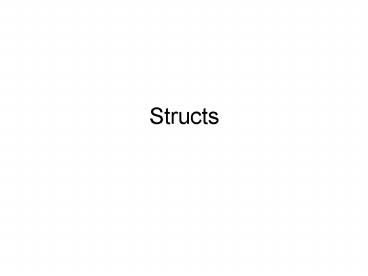Structs PowerPoint PPT Presentation
1 / 16
Title: Structs
1
Structs
2
Objectives
- Understand the mechanics of struct variables
- Understand why struct variables are used
- Understand how to design programs (functions)
that use structs
3
Why Structs?
- Frequently two or more variables are required to
represent one unit of information - A complex number has both a real and imaginary
part - A string (project 6) has both the array of
characters and the length - An employee record may have the name, social
security number, home address, etc., etc.
4
What is a struct
- A struct is an aggregate of multiple variables
- By defining a struct variable, we automatically
get all of the variables inside the struct - By passing the struct as an argument, we
automatically pass all the variables inside the
struct - Other than some minor alignment issues
- A struct is treated EXACTLY like the variables
that are inside it.
5
Syntax Struct Definition
- struct Employee
- char name
- int ssn
- char address
- The struct definition tells us how many, and what
types of variables are used to make up the
struct. - It does not actually create any of these
variables!
6
More on Struct Definitions
- The name of the struct can be (almost) anything
you like - I like to use names that begin with a capital
letter, typically nouns. - There can be as many variables in the struct as
you want. - The variables can be any type that you want
- The variables inside a struct can even be other
struct variables (not the same kind of struct)
7
Example
- struct Address
- char street
- char city
- char state
- int zip
- struct Employee
- char name
- int ssn
- Address home_address
8
Some Details
- NOTE Im using C struct syntax which is
slightly different from C - C creates two type names, e.g., both struct
Employee and Employee are names for the struct
type - C creates only one type name, struct Employee
- We can use a typedef in C to create the second
type name if we want it (I always do this in my C
programs)
9
Details Cont.
- A struct cannot have a variable inside it whose
type is the same as the struct - A struct can have a variable inside it whose type
is a pointer to the struct! - struct Blah
- int x
- Blah y // illegal, requires infinite memory
- struct Bleh
- int x
- Bleh p // perfectly fine, requires only 4
bytes for p
10
Beware the Ending
- This is the only place in C/C where you have
the sequence and its very easy to forget. - While were talking style I suggest that you
- Put your struct definitions in a .h file (and
include that file in any .cpp file that uses the
struct) - Do not declare actual struct variables in the
same statement that defines the struct type
11
Creating struct Variables
- int main(void)
- Employee fred // creates several variables
- fred.name Fred
- fred.ssn 111223333
- int p fred.ssn
- fred.home_address.street 1 university
station - Declare a struct variable (actually a collection
of variables) using the type name for the struct - Access the variables inside the struct using .
12
Assignment and Arguments
- Structs can be used (almost) as if they were
ordinary variables - Employee x
- x fred // assigns all variables inside x
- doit(x) // calls doit, and puts each of the
variables from x in the activation record - if (x.name fred.name x.ssn fred.ssn )
// illegal! cannot compare structs
13
Arrays of Structs
- Arrays and structs mix just fine (but can get a
little confusing) - Employee people100
- people0.name Fred
- Can get confusing if the struct has an array
inside it - struct Yuck
- int x100
- Yuck x100
- x2.x5 42 //yucky
14
Pointers and Structs
- If you calculate the address of a struct
- You get the address of the first byte in the
struct (just like with ordinary variables) - Obviously, this is also the address of the first
variable inside the struct - Dereferencing a pointer to a struct gives you a
reference to the struct - You would still use . to access the individual
variables inside the struct
15
The -gt shortcut
- Its tedious to type (and hard to read) programs
with lots of (p).x stuff - C/C provides an alternate syntax (that means
precisely the same thing) p-gtx - The -gt is just a convenience, you can use either
the (p).x or p-gt syntax, whatever youre most
comfortable with - Most experienced programmers use the p-gtx
- I personally think thats because most
experienced programmers (at least the C
experts) are bad typists.
16
Pass by Value?
- structs are passed just like ordinary variables
- A new struct is created in the activation record
- Hence, changing the parameter will not affect the
value of the original argument - void doit(Blah p)
- (p).x 42 // changes the memory location
pointed to by p - int main(void)
- Blah b
- b.x 0
- doit(b) // puts the ADDRESS of b into the
activation record - printf(d, b.x) // prints 42

